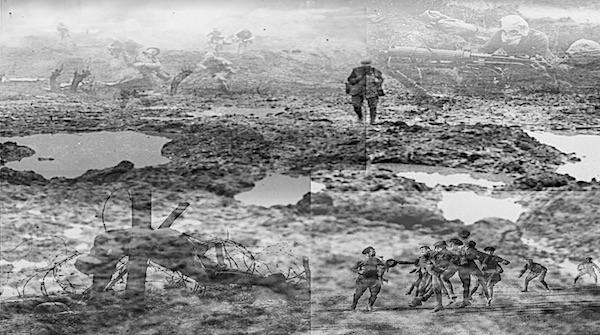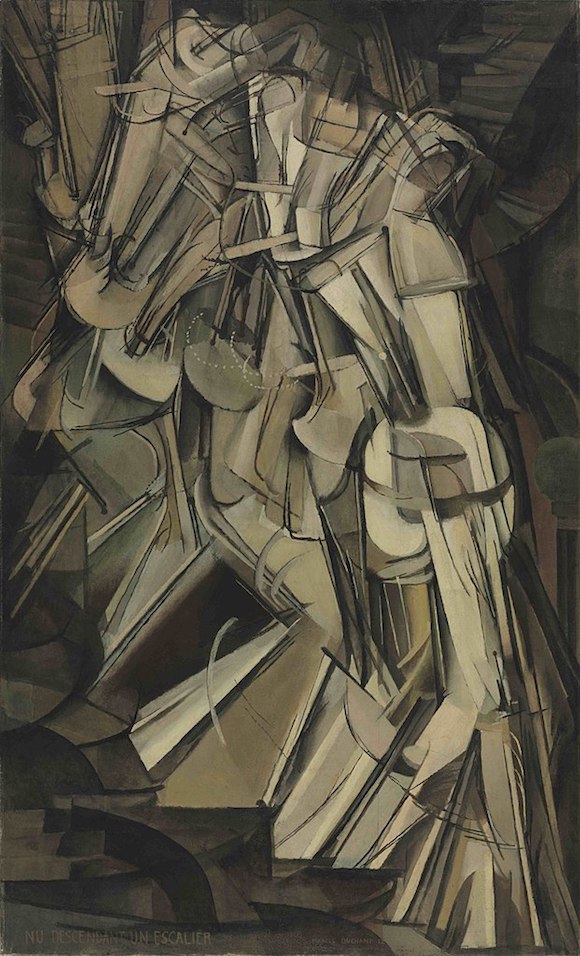
Max Ernst Ubu Imperator 1923

Ilargi: This is part 3 of Alexander Aston’s view of how upheaval and collapse can lead to new insights, new bursts of creativity, in science, religion, society and the arts. Part 1 of Quantum, Jazz and Dada can be found here, part 2 is here.
Here’s Alexander:

Quantum, Jazz and Dada:
The Dynamic Symmetry of Destruction and Creativity
Human Development
“Every breath is a sacrament, an affirmation of our connection with all other living things, a renewal of our link with our ancestors and a contribution to generations yet to come. Our breath is a part of life’s breath, the ocean of air that envelopes the earth.”
– David Suzuki
As human minds first started to emerge from the ocean and step onto the shores of Africa, they increasingly began to respond to their own presence. Hominids co-evolved through the complex social structures generated through the ecosystem engineering of tool using communities, forming a kind of “multicellular” cognition. The unique features of human cognitive evolution emerged from the dense feedback between brains, bodies, and their environments. As humans learn to engage with the material world around us we transform our collective developmental processes. “The structure of the brain reflects its history: as an evolving dynamic system, in which one part evolves out of another”. (20)
Tools made available whole new energetic niches for early hominins while sharing and cooperation increased group resiliency. This stimulated the growth of new neural structures capable of mediating the growing complexity of hominin interaction with the world. It is from these socio-cognitive ecologies that the phenomena we call history has emerged. What is clear from our deep past is that cooperative behaviour is overwhelmingly the dominant evolutionary characteristic of our species. Early Hominins that shared and reciprocated effectively created a broader distribution of resources that safeguarded against ecological change, thereby producing significant advantages in the face of adversity. In this sense, cooperative behaviour can be understood as a form of counteractive niche construction in which other members of the species provide a form of ecological storage to buffer against environmental variability.
The active structuring of relationships within a species creates unique adaptive landscapes that produce powerful and often novel forms of evolutionary feedback. Through interaction and cooperation, the social “body” itself becomes part of the ecological inheritance in which the organism develops. The greater the selective advantage afforded to cooperative behaviour the more complex the adaptive landscape becomes through collective behaviours and group size. Effective cooperation can help to ensure against the monopolisation of and exclusion from resources, enabling a more efficient circulation and distribution of resources through the social system.
Thus, the effectiveness of this strategy provides an advantage to those individuals more willing to engage in cooperative behaviour. What is critical about this is that it illuminates the idea that social organisation in of itself can be understood as a form of niche construction. Through socially structuring the material and energetic flows of their environments hominins created powerful feedback loops between social cognition and organisation. The ecological benefits of cooperative behaviours fuel their own expansion.
Human beings have developed such intense feedback between their environments, brains and bodies that we can engineer ecosystems and construct niches with very little impact upon our underlying genetics beyond what amounts to fine tuning. Nonetheless, human systems are still subject to the fundamental patterns from which they have emerged. In essence, humans “internalised” the logic of co-evolutionary ecologies, analogous to the way mammals localised thermal regulation. Our capacity to manipulate environmental structures and collectively adapt has led to unparalleled growth in organizational complexity throughout the course of human existence.
“The cultural transmission of knowledge and practices resulting from individual lifetime learning, when combined with the physical persistence of artefacts, yields yet another source of selection impacting feedback.” (21) In other words, the products of human activity become ecological entities shaping flows of energy, matter, and information in the environment. Our minds emerged in the wild, but over millennia we have engineered socio-technical ecosystems to shaping our development, our ways of knowing and being in the world. It is through the active structuring of energy-matter flows in our environment that we create the medium through which we think and act.
This interplay between material structure and flows of energy shape human engagement by encouraging and constraining interactive possibilities, and making new forms of meaning possible. It is in this sense that the most significant feature of human cognitive evolution is the feedback generated between the plasticity of the brain and the plasticity of the material environment. “Constant transformation of what is out there to be perceived facilitates further projections [that] over time… may construct a creative ecology of recursiveness and metacognition.” (22) Material culture allows us to engineer our ecosystems, forming “cognitive ecologies” that structure the contexts and possibilities of human development and interaction. (23) We grow from the world we help to create.

It is in these regards that the seeds of the next system must be sown in the dynamics of human development, social, emotional, intellectual and spiritual. The environments that we expose or subject ourselves to, shape how we think, relate and what we are capable of becoming. We must learn how to create healthy environments that support and empower human development in ways that are socially, economically and ecologically sustainable. Critical to this are intergenerational communities that allow us to observe and learn from the broad arc of human development, individual and collective. We also need educational processes that are truly dynamic. Experimental learning communities that are integrated into their societies are necessary. Yet, the most fundamental truth is that it will be co-operation that will be the single most critical trait that will lead to success. The more effective we are at sharing resources in mutual aid the more likely our systems will survive.
From Palaeolithic bands to the first city states and the contemporary global system, humans transform their environments, tapping new energetic resources and creating unique developmental pressures. As human social ecologies reach the limits of their growth or encounter novel conditions, people transform their energetic systems and their development. Human beings have gone from isolated bands to vast entanglements that dominate global ecology. Like atoms aggregating into stars and cells forming into bodies, minds have condensed into novel and dense relationships such as kinship networks, polities, religious communities, states and transnational empires. Diverse forms of human sociality have grown and withered countless times as unique cognitive ecologies,. The cosmos of identity and meaning that shaped our ancestors as they flourished, now erode in the elements, their ideas, knowledge and art forming the strata beneath our feet and the basis of our own understanding in the world.
Since the emergence of agriculture, elite groups have become extremely adept at dominating bottlenecks in the flows of complex systems, enabling them to reorganize social institutions around powerful monopolies and thereby establishing persistent, stratified political economies. Early states formed as identity cults with monopolies over specific behaviours and resources. In a sense, they were entropy-gathering mechanisms, domesticating and discipling human bodies in order to harness their energy and concentrate it in powerful cores. These hierarchical systems are effective at creating durable structures, yet their ability to create inertia also increases their fragility. The linear, overly centralised energy-matter flows of vertical control systems mean that they are only stable over a limited range of conditions as complexity increases. Not only do they often fail to adapt, but they are also powerful enough in the short term to fend off systemic changes, increasing the pressures upon the system as more energy is consumed to maintain stability.
This dynamic of inertia is where we stand at the end of the petroleum era with global institutions that developed around an immense energetic scaffolding of fossil fuels. These energetic throughputs have created powerful dominance hierarchies far beyond the scope of any previous social systems. The current “global” culture that has emerged from these processes comprises a unique way of understanding the world through developmental scaffolding afforded by industrial systems. “The assembling of ‘the economy’ [came] with the transition from a coal based energy system to a predominantly oil-base one… [a concept that] depended upon abundant and low-cost energy supplies, making post war Keynesian economics a form of ‘petroknowledge.’” (24)
Those at the core of the current system will resist changes because it is central to their very understanding of what the world is and how it functions. It is difficult for all humans to challenge and change the fundamental assumptions and logics of the systems in which we develop and create meaning, this all the more the case for the extremely privileged. Elites are at the centre of extremely dense and potent energetic flows that have developed into very powerful belief systems. It will doubtlessly require a great deal of energy and destruction to convince them of new possibilities. Such is the nature of all Ancien Régimes.
If we wish to create a new system, a healthier system for humanity, we must find ways of re-organising energetic flows from the ground up. There is no simple schema that can be imposed in such a process. Ecological design must emerge from its local context. The nature of sustainability will not be interchangeable across the globe. One of the critical things necessary for new, healthier systems to develop effectively is the decentralisation of production and consumption into locally stable configurations. There is no central authority with the sophistication necessary to impose a model or engineer a solution.
Down that path lay the horrors of the twentieth century. Rather, a new kind of society must emerge through negotiating the great diversity of human communities and their environments at multiple scales. What these social ecologies should share is a fundamental logic of co-evolutionary feedback, dynamic relational structures shaped by the flow and form of their environment. It is from those fundamental parameters that we can begin to organise new institutions. This requires engaging with the dynamics of the local environment and designing systems that harness and circulate energetic and material flows effectively.
The basis of our energetic systems is food production. It is critical that we begin to integrate our consumption with our ecosystems. There are many sophisticated techniques for bio intensive farming that have emerged over recent decades such as permaculture, hügelkultur, aquaponics and other experimental designs as well as extremely robust traditional practices across the world. Rethinking our systems from the ground up and engineering stable energetic feedback in our environments will allow us to reduce bottlenecks and increase local autonomy and resiliency. The more local the production of energy flows and their effective distribution in communities, the more they can create healthy developmental conditions as well as rapidly adapt to changing contexts.
This also can function as a way of creating counter power. Dominants (individual or institutional) will be less capable of creating differential access to resources and therefore dependency and power. Communities that harness their energy dynamics efficiently and effectively will have greater independence for they will be less susceptible to systemic coercion. Power, in a technical sense, is the expression of energetic capacity. The greater the autonomy of a community’s energetic capacity, the more power they can express in relation to the broader system. It is the counterbalance of power that creates stable feedback. Food autonomy is the cornerstone of this, from that foundation we must work to build counter economies, shaping new institutions around these energetic flows.
We must produce as much of our material needs from our immediate environment as possible. Recycle, reuse, repair while sustainably maintaining and harvesting local resources and reaching out to our broader communities for support in measured and considered ways. There are already many models and tools with which we can begin to design the institutions of a counter economy. DIY and maker spaces, cooperatives, social collectives, small businesses, sustainably powered micro-factories, all provide potential avenues for new networks of production and consumption. The point is to link up as many of these processes within our communities so that their synergy can start producing self-sustaining feedback.
Tools such as the P2P Foundation, Loomio, Opensource Ecology and countless other resources made available through digital culture allow us to design, implement and share in ways that can rapidly scale between local, regional and global, communities. Indeed, such resources opens the space for new forms of politics through consensus practices and highly refined, dynamically responsive voting structures. Through practice and participation we will learn how to create the next system as it emerges, co-evolving with it, creating it as it creates us. It is also critical that we do as much as possible to limit bottlenecks in informational networks.

It is only through communication and considered negotiation that we will be able to collectively adapt to the challenges that face us. The creation of alternative communication networks such as meshnets are extremely important, structurally distributed information flows ensure greater adaptability and coordination. This does not mean that we should not intersect with older or more traditional institutions. We should engage with those pre-existing structures that truly benefit our communities and learn how to transform and integrate them into new social configurations. We should also discover how to divert as many of the old systems energetic flows into new relationships, as long as such actions do not compromise our local systems.
Money is a powerful social technology by which we are undeniably dominated. Money mimics the dynamics of energy, acting as a kind of “fly-wheel” that facilitates the flow and storage of energetic capacity. “The flow of energy makes possible the circulation of money and the manipulation of money can control the flow of energy.” (25) In key ways, money is a cognitive artefact that humans use to store and express energetic capacity. Ultimately, it seems that if we want to have a materially grounded system of accountancy we should peg our currencies to measurable energetic flows. The creation of counter currencies, digital, local or otherwise, is one potentially fruitful avenue.
However, in our present circumstances, divestment from major banks into credit unions and other cooperative structures will help to ensure more democratic and local control over community wealth. Furthermore, the use of money to develop sustainable and shared resources is incredibly important. Investment into micro-grids, sustainable housing, community farms, consumer and producer cooperatives, tool libraries, time banks, transition towns and more, will all help to increase local resiliency. We must work to create configurations between such institutions that produce self-reinforcing dynamics. However, this does not mean that local communities will ever be fully disentangled from global flows of energy, only more resilient in the face of their disruption.
These dynamics must be mediated at local, regional and global scales. Indeed it would seem that one of the most potentially fruitful avenues for institutional frameworks would be to mimic the relational structure of the environment from ecosystems to biomes, ecotones and the biosphere. The communities and tools through which these processes are developing are far too numerous to detail. We should take heart that across the world communities are already developing solutions. Through observation, experimentation and communication we can begin to design feedback processes, positive and negative, that empower resilience and flexibility. The next system will emerge through communities working with the ecological flows in which they are embedded, developing new ways of articulating between the various scales of these processes. It will be a diverse kind of “Protestantism” rejecting and reorienting away from the demands of the current system as humanity searches for salvation.
Utopia and all that Jazz
“A map of the world that does not include Utopia is not worth even glancing at, for it leaves out the one country at which Humanity is always landing. And when Humanity lands there, it looks out, and, seeing a better country, sets sail. Progress is the realisation of Utopias.”
– Oscar Wilde
It was a song that encouraged soldiers to lay down their weapons and cross the lines on Christmas eve of 1914. Of all the things humans create, it is music that most closely resembles the reality of our universe, the dynamic symmetry of patterns in time. A tension between becoming and unbecoming shaping movement. Crescendo and dissolution, trough and peak. It has been over a century since that silent night, in which a fragile utopia emerged amidst the freshly dug trenches for Europe’s impending self-immolation.
What will we choose to sacrifice and create as the last of the industrial empires enter terminal decline? Across the globe connections are breaking and new spaces are being created, often with great violence. The demands of the old system exceed the Earth’s capacity and with every passing year, more and more people will be searching for new solutions. We must discover new ways to sing to one another and build our utopias not as end goals but as practices through which we can learn how to better take care of one another. We must create it together, in all our diversity, to give new meanings to the way we live.
It is our historical moment to be such a generation, to live amidst such immense forces of change. The high priests of our system fiercely deny this and demand ever more blood sacrifice from us to end the eclipse of their infinitely growing future. The very logic of their organization precipitates their extinction. However, if we embrace our position, balanced between destruction and creation, we can begin to create harmony amidst the crescendo of the old world. We live amongst dinosaurs. The meteor is coming. We must learn to be warm blooded, how to flower. Will our successional ecology be a golden age or a toxic one? The choice will be ours.
We must try to imagine and prefigure societies where human needs are met by systems of production sustainably embedded within ecological and thermodynamic processes. Imagine a world where children dive and play amongst the reefs formed by our submerged cities, their communities growing like gardens surrounded by vast tracts of wilderness, connected to new global networks. Perhaps they will ply the seas in ships that cast their sails into the stratosphere, transmit radio waves into space and still listen to the classic musicians of our times. Think of institutions where education and learning are free from linear economic narratives and embraced as one of the great joys and passions of the human mind.
A world where Art, Philosophy and Science are acts of joy and play, where generations are conscientiously integrated into community learning environments. Vibrant and diverse cultures that grow from sustainably designed communities powered with solar steam engines, eco-farms, cooperative institutions and more. It is beyond our knowing. All that we are certain of is that it is our generation, our actions that will create the possibilities of the future. The next system must emerge as a dynamic scaffolding of energy, matter and minds through which we can nurture new institutions. The ultimate outcome is beyond our comprehension, however the old world is reaching a crescendo and it’s denouement will be in the hands of those with the sense of vision and endeavour necessary to create something truly revolutionary.
Imagine…
The Industrials came from the ancient imperial-merchant cultures of Eurasia. Even today their ingenuity and technical prowess is astonishing. Their sciences still form much of the foundations of our knowledge, their stories continue to shape our identities. They were complex and contradictory peoples, capable of breath taking beauty and savage cruelty. Often one is left baffled at what they seemed unable to comprehend in themselves and their world, creating their own tragedies and traumas as if by compulsion. Yet, inexorably, the world changed. It would have been hard to see then, the seemingly disconnected and separate events that have only crystallised into history over the centuries.
There were signs of the gathering transformations at the beginning of the twenty-first century. Though the violence and trauma of the period was extreme, developments such as the Global Justice Movement, Chiapas, Occupy, Rojava, Nuit Debout, Standing Rock, and countless other innovations great and small were part of a gathering wave of transformation and reconfiguration. It was not a seamless and smooth process and over time it would create unanticipated problems that they and their descendants were forced to negotiate. Yet we owe much to those last generations of the industrial age.
Amidst all their challenges and shortcomings, they learned to create something new, an inheritance they have bequeathed us all. It must have often been terrifying and difficult during those final days of empire. Yet, as their world began to fall apart they started to produce whole new forms of art and philosophy, new systems of meaning and relationship, reshaping their communities and setting in motion the birth of the world we know today. Despite the horrors of their age, they still managed to create something beautiful. It is their redemption. They worked to build a renaissance rather than flee an apocalypse…
“We know that there is no help for us but from one another, that no hand will save us if we do not reach out our hand. And the hand that you reach out is empty, as mine is. You have nothing. You possess nothing. You own nothing. You are free. All you have is what you are, and what you give.”
– Ursula K. Le Guin

20) Iain McGilchrist, The Master and His Emissary: The Divided Brain and the Making of the Western World. (New Haven: Yale University Press, 2009), 255.
21) Andy Clark, Supersizing the Mind Embodiment, Action, and Cognitive Extension, (Oxford; New York: Oxford University Press 2008), 259.
22) Lambros Malafouris, How Things Shape the Mind: A Theory of Material Engagement, (Cambridge: MIT Press 2013), 193.
23) Edwin Hutchins, ‘Cognitive Ecology’. Topics in Cognitive Science 2, no. 4 (October 2010): 705-15.
24) Timothy Mitchell, Carbon Democracy: Political Power in the Age of Oil. (London: Verso 2013), 139.
25) Howard T Odum, Environment, Power, and Society for the Twenty-First Century: The Hierarchy of Energy, (New York: Columbia University Press 2007), 41.

Bibliography
Atkins, P. W. The Laws of Thermodynamics: A Very Short Introduction. Oxford: Oxford University Press, 2010.
Bookchin, Murray. The Ecology of Freedom: The Emergence and Dissolution of Hierarchy. Oakland: AK Press, 2005.
Christian, David. Maps of Time: An Introduction to Big History. Berkeley: University of California Press, 2011.
Carson, Kevin. Libertarian Municipalism: Networked Cities as Resilient Platforms for Post-Capitalist Transition. Centre for a Stateless Society, 2017.
Clark, Andy. Supersizing the Mind Embodiment, Action, and Cognitive Extension. Oxford: Oxford University Press, 2008.
Daly, Herman E., and Kenneth N. Townsend, eds. Valuing the Earth: Economics, Ecology, Ethics. Cambridge, Mass: MIT Press, 1993.
De Landa, Manuel. A Thousand Years of Nonlinear History. Swerve Editions. New York: Zone Books, 1997.
Dennett, Daniel C. Darwin’s Dangerous Idea: Evolution and the Meanings of Life. London: Penguin Books, 1996.
Descola, Philippe. The Ecology of Others: Anthropology and the Question of Nature. Chicago: Prickly Paradigm Press, 2012.
Forman, Paul. ‘Weimar Culture, Causality, and Quantum Theory, 1918-1927: Adaptation by German Physicists and Mathematicians to a Hostile Intellectual Environment’. Historical Studies in the Physical Sciences 3 (January 1971): 1–115.
Gosden, Chris, and Lambros Malafouris. ‘Process Archaeology (P-Arch)’. World Archaeology 47, no. 5 (20 October 2015): 701–17.
Graeber, David. Fragments of an Anarchist Anthropology. Paradigm 14. Chicago: Prickly Paradigm Press, 2004.
Gunderson, Lance H, and C. S Holling. Panarchy: Understanding Transformations in Human and Natural Systems. Washington, DC: Island Press, 2002.
Hastings, Alan, James E. Byers, Jeffrey A. Crooks, Kim Cuddington, Clive G. Jones, John G. Lambrinos, Theresa S. Talley, and William G. Wilson. ‘Ecosystem Engineering in Space and Time’. Ecology Letters 10, no. 2 (February 2007): 153–64.
Hodder, Ian. Entangled: An Archaeology of the Relationships between Humans and Things. Malden: Wiley-Blackwell, 2012.
Homer-Dixon, Thomas F. The Upside of down: Catastrophe, Creativity, and the Renewal of Civilization. Washington: Island Press, 2006.
Hutchins, Edwin. ‘Cognitive Ecology’. Topics in Cognitive Science 2, no. 4 (October 2010): 705–15.
Ingold, Tim. “Against human nature.” In Evolutionary epistemology, language and culture, pp. 259-281. Springer, Dordrecht, 2006.
Ingold, Tim. ‘Beyond Biology and Culture. The Meaning of Evolution in a Relational World’. Social Anthropology 12, no. 2 (19 January 2007): 209–21.
Johnson, Neil F. Simply Complexity: A Clear Guide to Complexity Theory. Oxford: Oneworld, 2009.
Laland, Kevin N., and Michael J. O’Brien. ‘Niche Construction Theory and Archaeology’. Journal of Archaeological Method and Theory 17, no. 4 (2010): 303–22.
Le Guin, Ursula K. The Dispossessed: An Ambiguous Utopia. New York: Harper Voyager, 2011.
Levin, Simon A. Fragile Dominion: Complexity and the Commons. Cambridge: Helix Books, 1999.
Malafouris, Lambros. How Things Shape the Mind: A Theory of Material Engagement. Cambridge, Massachusetts: MIT Press, 2013.
McGilchrist, Iain. The Master and His Emissary: The Divided Brain and the Making of the Western World. New Haven: Yale University Press, 2009.
McNeill, William Hardy. Plagues and Peoples. New York: Anchor Books, 1989.
Mitchell, Timothy. Carbon Democracy: Political Power in the Age of Oil. London: Verso, 2013.
Nichols, John J, Glenn M Schwartz, Society for American Archaeology, and Annual Meeting. After Collapse: The Regeneration of Complex Societies. Tucson: University of Arizona Press, 2010.
Odum, Howard T. Environment, Power, and Society for the Twenty-First Century: The Hierarchy of Energy. New York: Columbia University Press, 2007.
Rilke, Rainer Maria. Letters to a Young Poet. Novato, Calif: New World Library, 2000.
Russell, Edmund, James Allison, Thomas Finger, John K. Brown, Brian Balogh, and W. Bernard Carlson. ‘The Nature of Power: Synthesizing the History of Technology and Environmental History’. Technology and Culture 52, no. 2 (2011): 246–59.
Schneider, Eric D., and Dorion Sagan. Into the Cool: Energy Flow, Thermodynamics, and Life. Chicago: University of Chicago Press, 2006.
Scott, James C. Seeing like a State: How Certain Schemes to Improve the Human Condition Have Failed. New Haven, Conn: Yale University Press, 2008.
Shryock, Andrew, Daniel Lord Smail, and Timothy K. Earle, eds. Deep History: The Architecture of Past and Present. Berkeley: University of California Press, 2012.
Stotz, Karola. ‘Human Nature and Cognitive–developmental Niche Construction.’
Phenomenology and the Cognitive Sciences 9, no. 4 (December 2010): 483–501.
Suzuki, David T. The Sacred Balance: Rediscovering Our Place in Nature, Updated & Expanded. Vancouver: Greystone Books, 2007.
Tainter, Joseph A. The Collapse of Complex Societies. 23. print. New Studies in Archaeology. Cambridge: Cambridge Univ. Press, 2011.
Taylor, Paul D. Extinctions in the History of Life. Cambridge, U.K.; New York: Cambridge University Press, 2004.
Tuchman, Barbara W., and Robert K. Massie. The Guns of August. New York: Ballantine Books, 2004.
Watts, Alan. The Book: On the Taboo against Knowing Who You Are, 1989.
Wilde, Oscar, and Linda C. Dowling. The Soul of Man under Socialism and Selected Critical Prose. Penguin Classics. London: Penguin Books, 2001.

Alexander Aston is a doctoral candidate in archaeology at the University of Oxford and is on the board of directors with the Centre for Cognitive Archaeology at the University of Colorado in Colorado Springs. He has prior degrees in philosophy and history. His work lays at the intersection of Cognitive Archaeology, Deep History and Natural Philosophy, examining the relationship between ecology, material culture and social cognition. Alexander grew up between Zimbabwe, Greece and the United States. He has worked as a stone mason, community organiser and collaborative artist focused on issues of sustainability, alternative education and economic justice for nearly two decades. He has helped to establish community collectives, free schools, participatory art projects, sustainability and education programs in several international projects.











